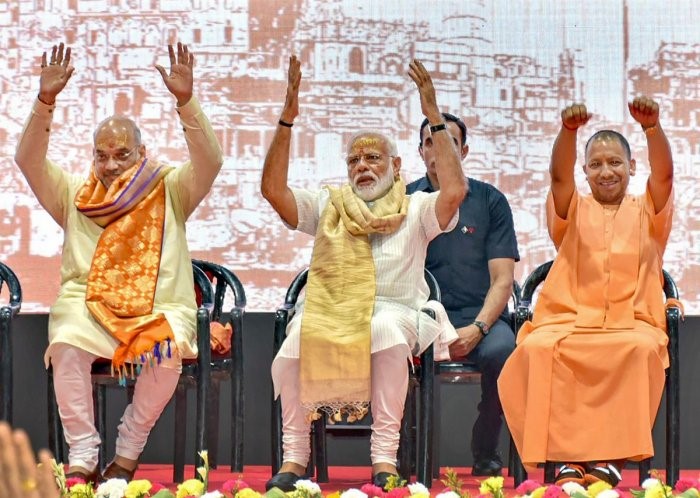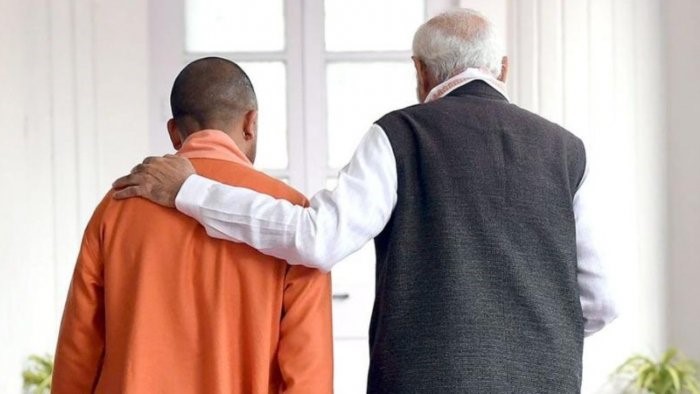
BJP's two most powerful leaders caught in a tense power triangle
The UP election verdict will change the inner dynamics of the BJP; the Mo-Shah combine has to contend with a key challenger - Adityanath

With assembly elections in Uttar Pradesh in its last stages, it is worth examining a subliminal refrain within the Bharatiya Janata Party that remained removed from its campaign pitch and voters’ response to it. Although uttered sotto voce, its post-verdict evolution will cast a shadow on inner dynamics within the ruling party for it is grounded in the tale of how a cosy twosome at the top of the hierarchy within the BJP, gradually, but unmistakably, transformed into a tense power triangle.
The BJP’s refrain in several state elections in recent years has been on how its ‘double-engine ki sarkar’ enabled efficient pro-people administration in states governed by them.
The slogan conveyed the message that having BJP governments in states and the Centre is always beneficial. Since 2014, most BJP-ruled states have seen chief ministers and the state leaderships playing supplementary roles to the Union government and national leaders.
More autonomous than peers
This template of an unassuming or low-profile chief minister was however, not followed in UP by Yogi Adityanath and he chose to be more autonomous than his peers. His unstated ambition to be not just one among equals has mired the power structure in the BJP.
After equations between the Narendra Modi-Amit Shah duopoly, collectively and individually, and Adityanath remaining visibly unsettled for the most part of 2021, a hesitant truce was forged due to the challenge in UP. Post-verdict, the equations will be either reworked or ironed out.
Adityanath’s distinctiveness from other satraps in the party and the propensity to publicise his personality and ‘achievements’ must be framed against the fact that he is an ‘outsider’ within the Sangh Parivar ecosystem having joined the BJP laterally.
After becoming chief minister, for the record, he disbanded Hindu Yuva Vahini, the organisation he floated and which worked independent of the Sangh Parivar. But an event in December 2021, where hate speeches were delivered demonstrated that this is only in name. Despite a formal association with the BJP for almost a quarter of a century, Adityanath retains the capacity to initiate action (and participate) independent or outside of the party and its front organisations.
Much before the BJP coined the concept of double-engine governance, the party established a dual power structure 2014 onwards. It functioned in tandem and the double-headed verticals – the government and party – headed by Prime Minister Narendra Modi and party president Amit Shah – made common cause to cement the party’s presence across India.
Also read: High stakes for Yogi Adityanath as Gorakhpur starts casting votes
The Mo-Shah combine became the undisputed Jodi No 1 within the party. While Modi remotely controlled the government apparatus, Shah as hands-on party president ensured that the party organisation acted as mouthpiece and publicist of Modi and the government.
Crowning glory of Modi-Shah duopoly
The 2017 electoral campaign in UP was among the crowning glories of this duopoly but their plans had to be somewhat reordered as a consequence of the unanticipated selection of Adityanath as chief minister for reasons that remain shrouded. On assuming office, the saffron-clad politician embarked on policies that endeared him to the hardcore Hindutva constituency. In time, he acquired an image that was independent of the central leadership.
Rabid tonality of Adityanath’s utterances, coupled with his virtuosity in public speaking, led to greater ‘demand’ for the Yogi than for Shah as ‘star’ campaigner in other states. Within hardliners, conversations establish that Adityanath has overtaken Shah in popularity because the former’s actions to ‘rein’ in minorities is ‘visible’, as against the latter’s initiatives which remain more at policy level or give effect to Modi’s decisions.
The Yogi as Modi’s possible successor became a subject discussed under the breath.
Only the absolute loyalist restrains one’s political ambition because someone else is uncomfortable with it and there is ambiguity if Adityanath qualifies to be labelled as such.
The first indication of Adityanath desiring to step out from the PM’s shadows surfaced in November 2020, on a day that Modi virtually met with chief ministers on COVID-19 management. That evening, Adityanath got his state cabinet to clear the ordinance (called anti-Jihad law) making inter-faith marriages more cumbersome.
Hindu Hriday Samrat 2.0
For long, there has been an unspoken diktat within the party that no one schedules headline-grabbing events on days of a ‘big’ Modi programme. This was evidence that Adityanath was positioning himself as Hindu Hriday Samrat 2.0 and a new version of Vikas Purush, with his thrust on copycat mega development projects.
Within two months, Modi’s trusted bureaucratic aide from Gujarat years, Arvind Kumar Sharma, prematurely retired from service amid speculations of an important political assignment in UP. Eventually, he settled for the inconsequential positions as member of state legislative council and one of the several vice-presidents of the state unit.
Why should a trusted IAS officer professionally wallow in unimportance? Does this have anything to do with Adityanath brooking no direct interference of the PMO?
Also read: UP polls a fight between dynasts, diehard nationalists: PM Modi
Subsequently, in one of the interactions with the power duo, the chief minister reportedly conveyed his view that the state leadership should be given primacy during assembly elections. The UP government’s publicity campaigns too promoted Adityanath as a leader on his own right.
For a fairly conspicuous period last year, Shah stayed away from political public rallies in UP despite launching the party campaign in Uttarakhand in November.

Image of all’s well
The eventual decision of the Mo-Shah combine to project Adityanath as the party mascot in UP was best symbolised by the ‘hand-on-shoulder’ photographs of the prime minister and the chief minister. It certainly led to Shah’s ‘demotion’ at least in the state. Yet he did not follow the grind of his other electoral campaigns till taking charge in the last two phases.
Significantly, Shah was asked in an interview with Indian Express some days ago that several “mention Adityanath as a future prime ministerial candidate.” He evaded the bait, sticking to rolling out the campaign pitch of “work done under him, after so many years.” He neither denied nor accepted the assertion but this indicated his obvious discomfort and that any conclusion about Adityanath’s future ascendance is not a ‘settled’ matter.
It is incorrect to term Adityanath’s display of ambition as rebellious. But, there is no ambiguity that despite his political appeal being limited to hardline Hindutva supporters, in Yogi, Modi is faced with the first potential ‘challenger’ to him from within.
Previously, potential challengers, or those who aspired to be in his shoes in the future, were cut to size – be it Shivraj Chouhan or Devendra Fadnavis. But, the election-eve political situation in UP did not allow for similar action and instead there was need to project an ‘all-is-well between us’ picture.
Although stakes are collectively high for the three, the verdict will impact their relative positions differently. A comfortable victory will undoubtedly strengthen Adityanath and correspondingly weaken Shah within the power triangle. Whether Yogi becomes more ambitious in the run-up to 2024 will depend on Modi and their ability to make common cause.
In case of a poor showing, the primary ‘blame’ will be on CM Adityanath and his ambitions will be dashed. It would, however, also have a negative effect on Modi’s narrative to 2024 but he would still have time and opportunity to make amends.
Success vs failure scenarios
The post-verdict scenario at the top of the BJP’s hierarchy will be as fascinating for observers as the unfolding situation in Opposition parties. The BJP has witnessed power tussles in the Vajpayee-Advani era (with MM Joshi at times being the third corner of a triangle)as well in the 1960s and 1970s during the Jana Sangh days.
Much of the narrative shall be shaped by the varying reasons that will be attributed to the BJP performance by the three and their loyalists – who should be credited for ‘success’ and on whose door ‘failure’ should lie, and most importantly for what reasons.
(The writer is a NCR-based author and journalist. His latest book is The Demolition and the Verdict: Ayodhya and the Project to Reconfigure India. His other books include The RSS: Icons of the Indian Right and Narendra Modi: The Man, The Times. He tweets at @NilanjanUdwin)
The Federal seeks to present views and opinions from all sides of the spectrum. The information, ideas or opinions in the article are of the author and do not necessarily reflect the views of The Federal)


